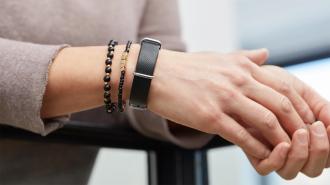Hypertension is one of the most widespread chronic diseases in the world: nearly a quarter of adults globally suffer from high blood pressure, including half of adults in the US. It’s called the “silent killer” because there are usually no symptoms, and it is deadly. In 2021 alone, hypertension caused or contributed to over 691,000 deaths in the US, according to the CDC.
But it does not have to be this way. Hypertension is very treatable — diet, physical activity, breathing exercises, and medication can all help keep it under control and limit the damage to your heart and blood vessels. But tracking your blood pressure is crucial for diagnosing and properly managing it. In the most serious cases, patients’ blood pressure must be monitored as frequently as possible to prevent pressure from reaching dangerous levels.
Hypertension is called the “silent killer” because there are usually no symptoms, and it is deadly.
This is extremely challenging to do throughout the day, outside of a hospital where patients are stuck in bed. But a new generation of wearable devices, already available in Europe, may be about to revolutionize how we study, monitor, and treat the disease.
The challenge: Many people suffering from hypertension are all too familiar with the struggle researchers face with creating accurate, comfortable techniques for regularly monitoring blood pressure.
So far, doctors have largely relied on inflating cuffs, which momentarily restrict blood flow to the arm. This procedure tends to be pretty disruptive to patients’ everyday lives if it needs to be carried out regularly. Patients need to stop, sit still, wait a few moments, and position the arm and cuff correctly.
Light-based monitoring: Recently, researchers have begun to explore a promising possible alternative to inflating cuffs, based on a technique named “photoplethysmography” (PPG). The approach depends on the fact that our blood absorbs varying amounts of light, depending on its volume and oxygen levels.
Wearable devices, like the Apple Watch, currently use similar techniques to measure heart rate and blood oxygen. But it could also reveal information about blood pressure.
By shining a light into the skin, then detecting the brightness of light reflected from the blood vessels inside, a PPG monitor worn by a patient could pick up on changes in their blood vessels, which can indicate blood pressure is reaching dangerous levels.
Aktiia’s device can be worn at night to gather data 24/7.
Introducing Aktiia: One company in Switzerland has now released a device which can do all of this on a comfortable, lightweight bracelet, embedded with an LED and light sensor. After a patient’s normal blood pressure is calibrated using an inflatable cuff, their bracelet can transform PPG signals gathered by the bracelet into accurate blood pressure estimates.
This data is then displayed in a user-friendly smartphone app via a Bluetooth connection, and can be stored on the bracelet for 30 days. The information can also be stored on Aktiia’s cloud server, where it can be easily accessed by patients and doctors.
Aktiia’s device can last for 2 weeks when fully charged, and can even be worn at night to gather data 24/7. The only requirement to maintain the monitor’s accuracy is to recalibrate once a month with an inflatable cuff.
Road to rollout: Over a series of recent studies, Aktiia has tested its monitor on hundreds of participants, with promising early results. Their studies have found that it’s accurate across a wide range of blood pressures, agreeing well with traditional cuff measurements. Importantly, it maintains its accuracy across a diverse array of participants, including wearers with darker skin, which absorbs more light and could potentially make PPG work differently.
Aktiia now plans to expand its rollout to North America as soon as possible.
The monitor still has some drawbacks. Since it can only take accurate measurements when the wearer isn’t moving, it can’t offer accurate information when they are exercising, or when they are feeling anxious or upset. Since the bracelet has only been tested on a limited number of people so far, more testing will be needed to confirm its reliability over more traditional methods.
Yet if the progress Aktiia has seen so far continues, the company hopes their device will ultimately improve the health and quality of life for millions of people globally.
Available in Europe at a cost of just over $250, Aktiia now plans to expand its rollout to North America as soon as possible. Further improvements to their design could even see the bracelet’s LED and light sensor integrated with smartwatches, making the monitor even more discrete and convenient.
We’d love to hear from you! If you have a comment about this article or if you have a tip for a future Freethink story, please email us at [email protected].





